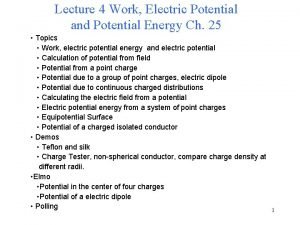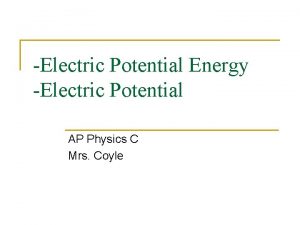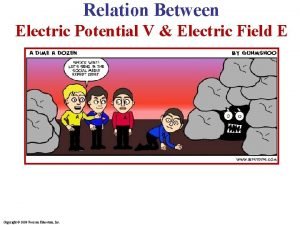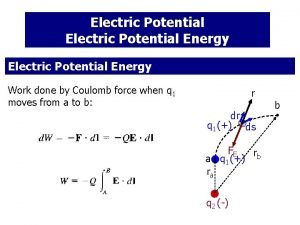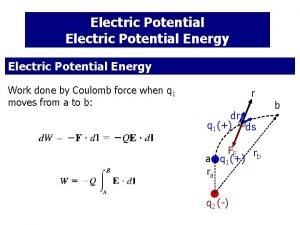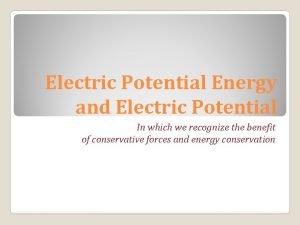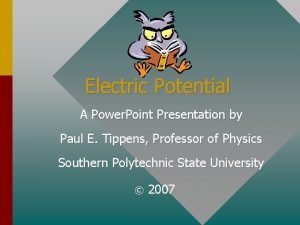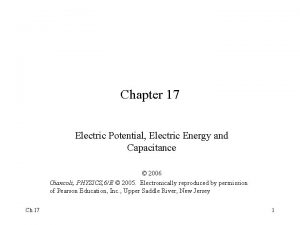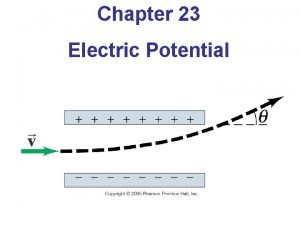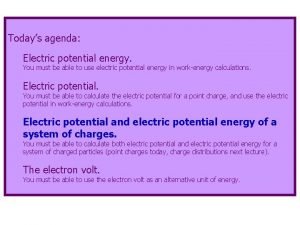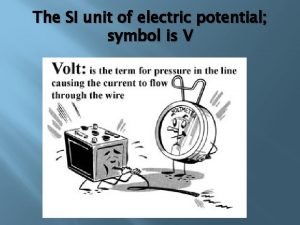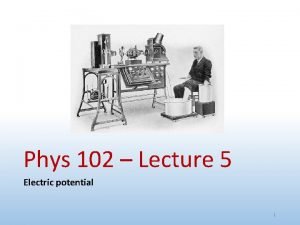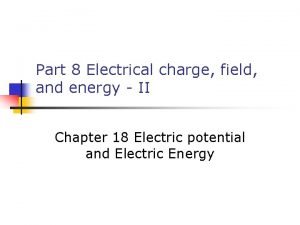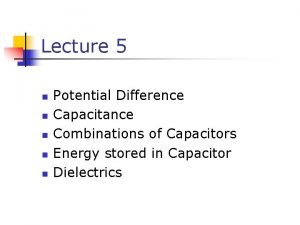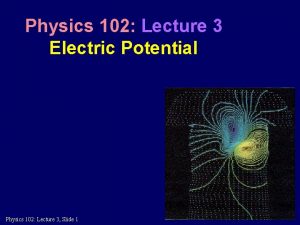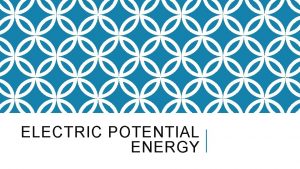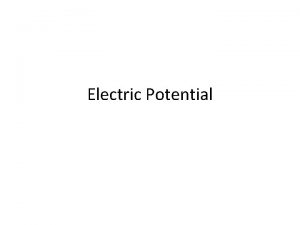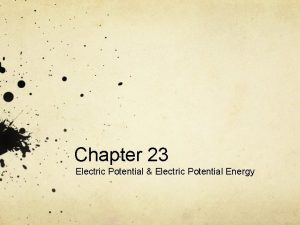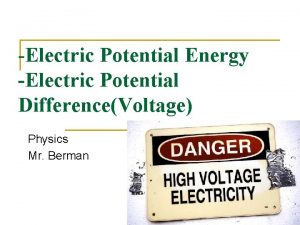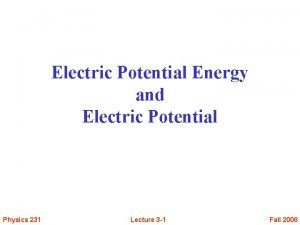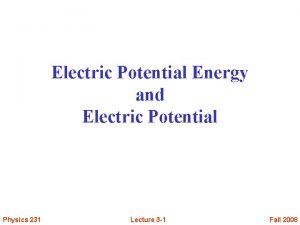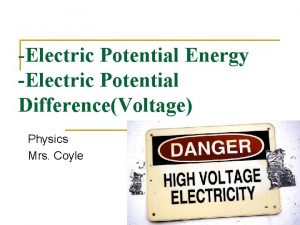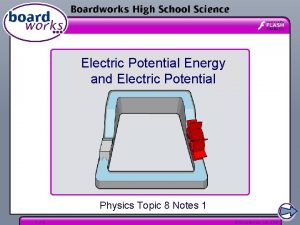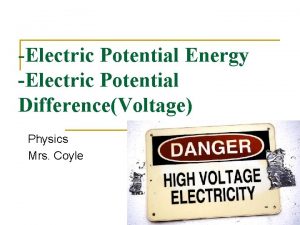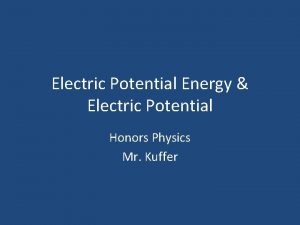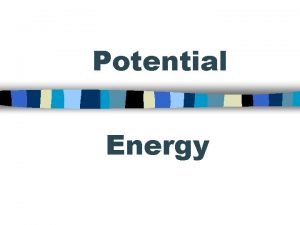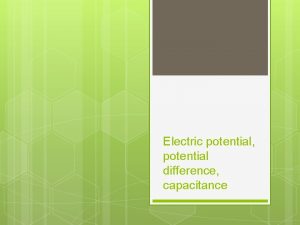Physics 102 Lecture 3 Electric Potential Energy Electric






















![Relationship between F, E, UE, V Number (“scalar”) F [N] UE [J] Ex: E Relationship between F, E, UE, V Number (“scalar”) F [N] UE [J] Ex: E](https://slidetodoc.com/presentation_image_h/b8ade1df8a69cc9cd9ecdd636baa22f1/image-23.jpg)


- Slides: 25

Physics 102: Lecture 3 Electric Potential Energy & Electric Potential Physics 102: Lecture 2, Slide 1

Overview for Today’s Lecture • Electric Potential Energy & Work – Uniform fields – Point charges • Electric Potential (like height) – Uniform fields – Point charges Physics 102: Lecture 2, Slide 2

Recall Work from Phys 101 • Work done by the force given by: – – W = F d cos(q) Positive: Force is in direction moved Negative: Force is opposite direction moved Zero: Force is perpendicular to direction moved • Careful ask WHAT is doing work! – Opposite sign for work done by you! • Conservative Forces – D Potential Energy = -Wforce Physics 102: Lecture 2, Slide 3

Preflight 3. 1 !!!!ACT!!!! C F – A B Uniform E In what direction does the force on a negative charge at point A point? 55% 1) left 43% 2) right 2% 3) up Physics 102: Lecture 2, Slide 4 Electric field points in the direction a POSITIVE charge would feel force.

Preflight 3. 2 “I would say zero because the path is perpendicular to the field” motion C F - A B Uniform E When a negative charge is moved from A to C the ELECTRIC force does 8% 1) positive work. 88% 2) zero work. 4% 3) negative work. Physics 102: Lecture 2, Slide 5

Preflight 3. 3 “because the direction of the displacement is 180 degrees from direction of the force ” C A F - Uniform E B motion When a negative charge is moved from A to B the ELECTRIC force does 66% 1) positive work. 5% 2) zero work. 29% 3) negative work. Physics 102: Lecture 2, Slide 6 ΔUE = -WE field = +WYou Electric force did negative work You did positive work Electric potential energy increased

ACT: Work WA-B = work done by FE moving charge from A to B C A F - B Uniform E The negative charge is moved from A to C to B. Is the work done by the electric force: A) Greater than WA-B B) Same as WA-B C) Less than WA-B Physics 102: Lecture 2, Slide 7 Path does not matter! Only end points matter

Work and D Potential Energy W = F d cos(q) Gravity • Brick raised yi yf • FG = mg (down) • WG = –mgh • DUG= +mgh Electric • Charge moved xi xf • FE = q. E • WE = –q. Ed • DUE= +q. Ed (left) yf xi h F - yi FG=mg Physics 102: Lecture 2, Slide 8 d E xf

E. P. E. for point charges E. P. E. of two charges q 1 and q 2 separated a distance r: What is the electric potential energy of an electron a distance r = 0. 53 10 -10 m from a proton (H atom)? UE = (+1. 6 10 -19)(-1. 6 10 -19)/0. 53 10 -10 = -4. 35 10 -18 J rf = 0. 5 10 -10 m + Physics 102: Lecture 2, Slide 9 -

Work done by YOU to assemble 3 charges • W 1 = 0 • W 2 = k q 1 q 2 /r =(9 109)(1 10 -6)(2 10 -6)/5 =3. 6 m. J • W 3 = k q 1 q 3/r + k q 2 q 3/r (9 109)(1 10 -6)(3 10 -6)/5 + (9 109)(2 10 -6)(3 10 -6)/5 =16. 2 • • • Wtotal = +19. 8 m. J WE = – 19. 8 m. J DUE = +19. 8 m. J (watch signs!) Physics 102: Lecture 2, Slide 10 5 m 1 3 5 m 5 m 2 m. J

ACT: Work done by YOU to assemble 3 negative charges How much work would it take YOU to assemble 3 negative charges? Likes repel, so YOU will still do positive work! A) W = +19. 8 m. J B) W = 0 m. J C) W = -19. 8 m. J Physics 102: Lecture 2, Slide 11 5 m 1 3 5 m 5 m 2

Preflight 3. 11 1 5 m 2 + + 5 m 5 m - 3 The total work required by you to assemble this set of charges is: 50% (1) positive Bring in (1): zero work 18% (2) zero Bring in (2): positive work 32% (3) Physics 102: Lecture 2, Slide 12 negative Bring in (3): negative work x 2

Electric Potential (like height) • Units Joules/Coulomb Volts • Examples: – Batteries – Outlets – EKG • Only potential differences matter Physics 102: Lecture 2, Slide 13

Electric Potential (like height) Devil’s Tower Topographical map Moving to higher potential moving uphill Physics 102: Lecture 2, Slide 14

Demo: electric potential Recall electric dipole + Equipotential lines + – – • + (–) charge has high (low) potential Electric field • Equipotential lines at same “height” • Electric field lines point “downhill” Physics 102: Lecture 2, Slide 15

Preflight 3. 7 Electric field Points from greater potential to lower potential The electric potential at point A is _______ at point B 45% 1) greater than 32% 2) equal to 23% 3) less than Physics 102: Lecture 2, Slide 16

Preflight 3. 9 E=0 conductor The electric potential at point A is _______ at point B 7% 1) greater than 85% 2) equal to 7% 3) less than Physics 102: Lecture 2, Slide 17 “The electric field within a conductor is zero, and therefore, the potential for points A and B are the same”

Potential for Point charges Electric potential a distance r from a charge q: What is the electric potential a distance r = 0. 53 10 -10 m from a proton? (Let V( )=0) V =UE/q= k q/ r = (9 109)(1. 6 10 -19) /0. 53 10 -10 = 27. 2 Volts rf = 0. 5 10 -10 m + Physics 102: Lecture 2, Slide 18

Two Charges • Calculate electric potential at point A due to charges – Calculate V from +7 m. C charge – Calculate V from – 3. 5 m. C charge – Add (EASY! NO VECTORS) A 4 m V = kq/r V 7 = (9 109)(7 10 -6)/5 = 12. 6 103 V V 3 = (9 109)(-3. 5 10 -6)/5 = -6. 3 103 V Vtotal = V 7+V 3 = +6. 3 103 V Q=+7. 0 m. C How much work do you have to do to bring a 2 m. C charge from far away to point A? Physics 102: Lecture 2, Slide 19 6 m Q=-3. 5 m. C W=DU=Vq = (+6. 3 103 V)(2 m. C) = +12. 6 m. J

ACT: Two Charges • In the region II (between the two charges) the electric potential is 1) always positive 2) positive at some points, negative at others. 3) always negative I II Q=+7. 0 m. C III Q=-3. 5 m. C Very close to positive charge potential is positive Very close to negative charge potential is negative Physics 102: Lecture 2, Slide 20

ACT: Electric Potential + E C A B The electric potential at A is ______ the electric potential at B. 1) greater than 2) equal to 3) less than Physics 102: Lecture 2, Slide 21 1) Electric field lines point “down hill” 2) AC is equipotential path (perpendicular to E) 3) CB is down hill, so B is at a lower potential than (“down hill from”) A

Comparison: Electric Potential Energy vs. Electric Potential • Electric Potential Energy (U) - the energy of a charge at some location. • Electric Potential (V) - found for a location only – tells what the EPE would be if a charge were located there (usually talk about potential differences between two locations): U = Vq • Neither has direction, just value. Sign matters! Physics 102: Lecture 2, Slide 22
![Relationship between F E UE V Number scalar F N UE J Ex E Relationship between F, E, UE, V Number (“scalar”) F [N] UE [J] Ex: E](https://slidetodoc.com/presentation_image_h/b8ade1df8a69cc9cd9ecdd636baa22f1/image-23.jpg)
Relationship between F, E, UE, V Number (“scalar”) F [N] UE [J] Ex: E [N/C]=[V/m] V Ex: po Prop in er t i ty n sp of ac e in te Pro ra p ct er in ty g ch of ar ge s Vector [J/C]=[V] Why so many ways to describe electric force? Physics 102: Lecture 2, Slide 23

Electron microscope ΔV=10 k. V Vi - Vf Electron gun Uniform E motion • What is the final velocity of the e-? • Solve by conservation of energy: K. E. i + P. E. i = K. E. f + P. E. f 0 + –e. Vi = ½mv 2 + –e. Vf Physics 102: Lecture 2, Slide 24 Could solve this using F=ma & kinematic equations (Phys 101) TRY AT HOME! (HARDER)

See everyone Monday! Physics 102: Lecture 2, Slide 25
 Electrical potential energy
Electrical potential energy Electric potential unit
Electric potential unit Pe=qed
Pe=qed Electric potential lecture
Electric potential lecture Physics 102
Physics 102 Define electric potential and potential difference.
Define electric potential and potential difference. Electric potential inside non conducting sphere
Electric potential inside non conducting sphere Joules per coulomb
Joules per coulomb Energy of an electric field
Energy of an electric field Ap physics c electric potential
Ap physics c electric potential Electric potential and electric field
Electric potential and electric field Work energy theorem
Work energy theorem Relation between electric field and potential energy
Relation between electric field and potential energy Coulomb force potential energy
Coulomb force potential energy Potential energy of an electric field
Potential energy of an electric field What is the potential at point a
What is the potential at point a Absolute potential energy
Absolute potential energy Kinetic energy of electron
Kinetic energy of electron Energy formula
Energy formula Relation between potential energy and electric field
Relation between potential energy and electric field Electric potential energy
Electric potential energy Si unit of electric potential
Si unit of electric potential Electric potential energy
Electric potential energy Electric potential energy
Electric potential energy Electric potential energy
Electric potential energy Mgh gpe
Mgh gpe



